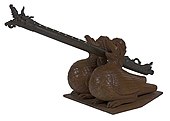Mandau (knife)
| Mandau | |
|---|---|
 A Mandau complete with a Langgei Puai (whittling blade), pre-1927. | |
| Type | Sword, Cutlass, Ceremonial blade |
| Place of origin | Borneo (Brunei, Indonesia, Malaysia) |
| Service history | |
| Used by | Dayak (Sea Dayak, Bidayuh, Kayan, Kenyah, Penan, Lun Bawang/Lundayeh) |
| Specifications | |
| Blade type | Single edge, one side convex and concave on the other side |
| Hilt type | Antler/deer horn, wood, animal or human hair |
| Scabbard/sheath | Wood, antler or bone fittings, animal or human hair |
Mandau[1] is the traditional weapon of the Dayak people of Borneo.[2][3] It is also known as Parang Ilang among the Bidayuh, Iban and Penan people, Malat by the Kayan people or Baieng by the Kenyah people or Bandau by Lun Bawang or Pelepet/Felepet by Lundayeh. Mandau is mostly ceremonial. However, a less elaborate version called Ambang is used as an everyday practical tool.
Associated with the Headhunting Ceremony, where people would gather to attack other tribes, and gather heads to be used in various festivities, Mandau is both a work of art in itself and a weapon.
Description
[edit]
Characteristics for the Mandau is that the blade is shaped convexly on one side and somewhat concavely on the other side.[4] The blade is mostly made of tempered metals, with exquisite vine-works and inlaid brass. The hilt is made from animal horns, such as deer's horns, although some variations with human bones and fragrant wood also have been found. Both the hilt and scabbard are elaborately carved and plumed. Details of carvings vary from tribe to tribe, but mostly depict creatures or, if human bones were used, anthropomorphic deities. A Mandau is often accompanied with a whittling knife, generally referred to as Pisau raut.
Ambang
[edit]Ambang is a term used for Mandau that is made from common steel. Often it is also made as souvenir. For the untrained eye and those who are not familiar with the Mandau, will not be able to distinguish the difference between a Mandau and an Ambang because of the outlook appearance that looks almost similar. However the two are actually very different. If one examines in detail, the differences are very obvious that the engravings can be found on the blade and it is embedded with gold, copper or silver. The Mandau holds a stronger edge and with flexibility, as it is said that the Mandau is made from iron ore obtained from rocky mountains forged by skilled blacksmiths. Whereas the Ambang is made from ordinary steel.[5]
In popular culture
[edit]As a symbol of Dayak culture, mandau is frequently depicted in various ways. Indonesian provinces of East Kalimantan, West Kalimantan, and Central Kalimantan all featured mandau in their provincial emblem.[6][7][8] Paramilitary organization Mandau Talawang Pancasila was named after the weapon.[9] Insignia of military command Kodam VI/Mulawarman and Kodam XII/Tanjungpura in Indonesia also featured mandau.
See also
[edit]References
[edit]- ^ Active Interest Media, Inc. (October 1984). "Black Belt". Black Belt. Buyer's Guide. Active Interest Media, Inc.: 41–. ISSN 0277-3066.
- ^ Lumholtz, Carl (1920). Through Central Borneo. C. Scribner's sons. ISBN 978-1-314-54676-7.
- ^ unknown (2003). "Arts of Asia – Volume 33, Issues 4-6". Arts of Asia. Arts of Asia Publications, University of Virginia. ISSN 0004-4083.
- ^ Albert G Van Zonneveld (2002). Traditional Weapons of the Indonesian Archipelago. Koninklyk Instituut Voor Taal Land. ISBN 90-5450-004-2.
- ^ Yuyus Kardiman, Yasnita Yasin, Aslidar & Windi Marathun Sholiha (2010). Masyarakat Indonesia: teropong antropologi budaya Indonesia. Laboratorium Sosial Politik Press. ISBN 978-60-287-6809-2.
{{cite book}}: CS1 maint: multiple names: authors list (link) - ^ Fikry, Muhammad I. (2017-09-20). "Logo Provinsi Kalimantan Tengah". DINAS PERUMAHAN, KAWASAN PERMUKIMAN DAN PERTANAHAN. Retrieved 2022-02-05.
- ^ "Arti dan Makna Lambang Provinsi Kalimantan Barat". Tribunpontianak.co.id (in Indonesian). Retrieved 2022-02-05.
- ^ "Lambang". kaltimprov.go.id. Retrieved 2022-02-05.
- ^ van Klinken, Gerry (2006-04-01). "Colonizing Borneo: State-Building and Ethnicity in Central Kalimantan". Rochester, NY. SSRN 1876543.
{{cite journal}}: Cite journal requires|journal=(help)



